Phytoremediation Performance with Ornamental Plants in Monocultures and Polycultures Conditions Using Constructed Wetlands Technology
Abstract
1. Introduction
2. Results and Discussion
2.1. Physic-Chemical Parameters
2.2. Plant Growth
2.3. Pollutant Concentrations and Removals
2.4. Analysis of the Environmental Impact in CWs with Different Culture Plants
3. Materials and Methods
3.1. Description Techniques and Study Area
3.2. Sampling and Analytical Methods
3.3. Phytoremediation Performance of Environmental Impact of CWs with Different Culture Plants
3.4. Statistical Analysis
4. Conclusions
Author Contributions
Funding
Data Availability Statement
Acknowledgments
Conflicts of Interest
References
- Mitsch, W.J.; Gosselink, J.; Anderson, C.J.; Fennessy, M.S. Wetlands, 6th ed.; John Wiley and Sons Inc.: New York, NY, USA, 2023; p. 672. [Google Scholar]
- Navarro, A.; Hernández, M.E.; Bayona, J.M.; Morales, L.; Ruiz, P. Removal of selected organic pollutants and coliforms in pilot constructed wetlands in southeastern Mexico. Int. J. Environ. Anal. Chem. 2011, 91, 680–692. [Google Scholar] [CrossRef]
- Zamora, S.; Marín-Muñiz, J.L.; Nakase-Rodríguez, C.; Fernández-Lambert, G.; Sandoval, L. Wastewater treatment by constructed wetland eco-technology: Influence of mineral and plastic materials as filter media and tropical ornamental plants. Water 2019, 11, 2344. [Google Scholar] [CrossRef]
- Marín-Muñiz, J.L.; Hernández, M.E.; Gallegos-Pérez, M.; Amaya-Tejeda, S. Plant growth and pollutant removal from wastewater in domiciliary constructed wetland microcosms with monoculture and polyculture of tropical ornamental plants. Ecol. Eng. 2020, 147, 105658. [Google Scholar] [CrossRef]
- Ezeah, C.; Ríos, C.A.; Contreras, J.F. Constructed wetland systems as methodology for the treatment of wastewater in Bucaramanga industrial park. J. Geoscien. Environ. Prot. 2015, 3, 1–14. [Google Scholar] [CrossRef]
- Vymazal, J.; Březinová, T. The use of constructed wetlands for removal of pesticides from agricultural runoff and drainage: A review. Environ. Int. 2015, 75, 11–20. [Google Scholar] [CrossRef] [PubMed]
- Marín-Muñiz, J.L.; García-González, M.C.; Ruelas-Monjardín, L.; Moreno-Casasola, P. Influence of different porous media and ornamental vegetation on wastewater pollutant removal in vertical subsurface flow wetland microcosms. Environ. Eng. Sci. 2018, 35, 88–94. [Google Scholar] [CrossRef]
- Paucar, E.; Sato, C. An Overview of Microbial Fuel Cells within Constructed Wetland for Simultaneous Nutrient Removal and Power Generation. Energies 2022, 15, 6841. [Google Scholar] [CrossRef]
- Cervantes-Alcalá, R.; Arrocha-Arcos, A.A.; Peralta-Peláez, L.A.; Ortega-Clemente, L.A. Electricity generation in sediment plant microbial fuel cells (SPMFC) in warm climates using Typha domingensis Pers. Int. Res. J. Biotech. 2012, 3, 166–173. Available online: http://www.interesjournals.org/IRJOB (accessed on 20 December 2023).
- Hernández, M.E. Ornamental wetlands with community participation for treatment of municipal wastewater in Mexico. Rev. Int. Des. Reg. Sust. 2016, 1, 1–12. [Google Scholar]
- Kadlec, R.; Wallace, S. Treatment Wetlands, 2nd ed.; Taylor and Francis: Abingdon, UK, 2009; 366p. [Google Scholar]
- Papaevangelou, V.; Gikas, G.; Tsihrintzis, V. Effect of Operational and Design Parameters on Performance of Pilot-Scale Vertical Flow Constructed Wetlands Treating University Campus Wastewater. Water Resour. Manag. 2016, 30, 5875–5899. [Google Scholar] [CrossRef]
- Rodriguez-Dominguez, M.; Konnerup, D.; Brix, H.; Arias, C. Constructed Wetlands in Latin America and the Caribbean: A review of experiences during the last decade. Water 2020, 12, 1744. [Google Scholar] [CrossRef]
- García-García, P.; Ruelas Monjardín, L.; Marín-Muñiz, J.L. Constructed wetlands: A solution to water quality issues in Mexico? Water Policy 2016, 18, 654–669. [Google Scholar] [CrossRef]
- Marín-Muñiz, J.L. Humedales construidos en México para el tratamiento de aguas residuales, producción de plantas ornamentales y reúso del agua. Agroproductividad 2017, 10, 90–95. Available online: https://revista-agroproductividad.org/index.php/agroproductividad/article/view/1028 (accessed on 17 July 2022). (In Spanish).
- Zurita, F.; Roy, E.; White, J. Municipal wastewater treatment in Mexico: Current status and opportunities for employing ecological treatment systems. Environ. Technol. 2012, 33, 1151–1158. [Google Scholar] [CrossRef] [PubMed]
- Sandoval, L.; Alvarado-Lassman, A.; Marín-Muñiz, J.L.; Rodríguez-Miranda, J.; Fernández-Lambert, G. A critical review of mineral substrates used as filter media in subsurface constructed wetlands: Costs as a selection criterion. Environ. Technol. Rev. 2023, 12, 251–271. [Google Scholar] [CrossRef]
- Shiwei, C.; Zhaoqian, J.; Peng, Y.; Wang, Y.; Wang, Y. Performance of constructed wetlands with different substrates for the treated effluent form the municipal sewage plant. J. Water Reuse Desalination 2019, 9, 452–462. [Google Scholar] [CrossRef]
- Huo, J.; Hu, X.; Cheng, S.; Xie, H.; Hu, Z.; Wu, H.; Liang, S. Effects and mechanisms of constructed wetlands with different substrates on N2O emission in wastewater treatment. Environ. Sci. Pollut. Res. Int. 2022, 29, 19045–19053. [Google Scholar] [CrossRef] [PubMed]
- Liang, M.Q.; Zhang, C.F.; Peng, C.L.; Lai, Z.L.; Chen, D.F.; Chen, Z.H. Plant growth, community structure, and nutrient removal in monoculture and mixed constructed wetlands. Ecol. Eng. 2011, 37, 309–316. [Google Scholar] [CrossRef]
- Carrillo, V.; Casas-Ledón, Y.; Neumann, P.; Vidal, G. Environmental performance of constructed wetland planted with monocultures and polycultures for wastewater treatment. Ecol. Eng. 2023, 193, 107015. [Google Scholar] [CrossRef]
- Morelli, B.; Hawkins, T.; Niblick, B.; Henderson, A.; Golden, H.; Compton, J.; Cooter, E.; Bare, J. Critical review of eutrophication models for life cycle assessment. Environ. Sci. Technol. 2018, 52, 9562–9578. [Google Scholar] [CrossRef] [PubMed]
- Ekhlasur, M.; Izuan, M.; Yusoff, M.; Kamal, M.; Mahmud, K.; Yunus, M. Design, operation and optimization of constructed wetland for removal of pollutant. Int. J. Environ. Res. Public Health 2020, 17, 8339. [Google Scholar] [CrossRef]
- Sánchez-Olivares, E.; Marín-Muñiz, J.L.; Hernández-Alarcón, M.E. Radial oxygen loss by roots of native tropical wetland plants of Veracruz in response of different flooding conditions. Bot. Sci. 2019, 97, 202–210. [Google Scholar] [CrossRef]
- Lobo-Arias, M.; Medina-Cano, C.; Grisales-Arias, J.D.; Yepes-Agudelo, A.F.; Álvarez-Guzmán, J.A. Evaluation and morphological characterization of the Colombian collection of achira Canna edulis Ker Gawl. (cannaceae). Rev. Cienc. Y Tecnol. Agropecu. 2017, 18, 47–73. [Google Scholar] [CrossRef]
- Izaka, E.; Agbontaen, O. Dieffenbachia sequine (Jacq.) Scott (Araceae)—A potential invasive threat to rainforest ecosystems in Nigeria aceous plant in Nigeria. Niger. J. Bot. 2015, 25, 1–12. Available online: https://www.researchgate.net/publication/280876328_Dieffenbachia_sequine_Jacq_Scott_Araceae_-_a_potential_invasive_threat_to_rainforest_ecosystems_in_Nigeriaaceous_plant_in_Nigeria#fullTextFileContent (accessed on 1 February 2024).
- Torres, L.J. Tecnología para el Cultivo del Sagú o Achira (Canna edulis Ker); Corpoica, Secretaría de Agricultura y Desarrollo Rural: Bogotá, Colombia, 2004; Available online: https://repository.agrosavia.co/handle/20.500.12324/2117 (accessed on 25 July 2023).
- Sandoval, L.C.; Zurita, F.; Del Ángel-Coronel, O.A.; Adame-García, J.; Marín-Muñíz, J.L. Influence of a new ornamental species (Spathiphyllum blandum) on the removal of COD, nitrogen, phosphorus and fecal coliforms: A mesocosm wetland study with PET and tezontle substrates. Water Sci. Technol. 2020, 81, 961–970. [Google Scholar] [CrossRef]
- Shelef, O.; Gross, A.; Rachmilevitch, S. Role of plants in a constructed wetland: Current and new perspectives. Water 2013, 5, 405–419. [Google Scholar] [CrossRef]
- Wang, C.; Zheng, S.; Wang, P.; Quian, J. Effects of vegetations on the removal of contaminants in aquatic environments: A review. J. Hydrodyn. 2014, 26, 497–511. [Google Scholar] [CrossRef]
- Nakase, C.; Zurita, F.; Nani, G.; Reyes, G.; Fernández-Lambert, G.; Cabrera-Hernández, A.; Sandoval, L. Nitrogen removal form domestic wastewater and the development of tropical ornamental plants in partially saturated mesocosm-scale constructed wetlands. Int. J. Environ. Res. Public Health 2019, 16, 4800. [Google Scholar] [CrossRef]
- Comisión Nacional del Agua (CONAGUA). Estadísticas del agua en México; Secretaría de Medio Ambiente y Recursos Naturales (SEMARNAT): México, México, 2017; p. 294. Available online: http://sina.conagua.gob.mx/publicaciones/EAM_2017.pdf (accessed on 10 April 2023).
- Vera, A.; Andrade, C.; Flores, E.; Núñez, M.; Cárdenas, C.; Morales, E. Remoción de nutrientes y materia orgánica en un humedal construido en función del desarrollo de la macrófita Typha dominguensis Pers. Rev. Técnica Fac. Ing. Univ. Zulia 2010, 33, 153–163. (In Spanish) [Google Scholar]
- Russell, D.L. Practical Wastewater Treatment; John Wiley & Sons: Hoboken, NJ, USA, 2019; Available online: https://books.google.com.mx/books?hl=es&lr=&id=F6mMDwAAQBAJ&oi=fnd&pg=PR17&dq=+in+Mexico,+monitors+water+bodies+have+established+that+an+acceptable+criterion+COD+discharge+biologically+treated+wastewater+must+not+exceed+40+mg/L+&ots=fGvreeyPSF&sig=t74EfHW3bcT7GLhmGNhjA6_BjHs#v=onepage&q&f=false (accessed on 15 June 2019).
- Luo, Y.; Chen, Q.; Liu, F.; Dai, C. Both species richness and growth forms affect nutrient removal in constructed wetlands: A mesocosm experiment. Front. Ecol. Evol. 2023, 11, 1139053. [Google Scholar] [CrossRef]
- Wetzel, R. Limnología Omega, 1st ed.; SA: Barcelona, Spain, 1981; 679p. [Google Scholar]
- EPA/5401/1-86/060; United States Environmental Protection Agency, Superfund Public Health Evaluation Manual. USEPA: Washington, DC, USA, 1986.
- Kurniawati, L.; Bisri, M.; Harisuseno, D.; Yuliani, E. Abilities of stratified filter and wetland to reduce TDS and TSS in blackwater domestic waste. IOP Conf. Ser. Mater. Sci. Eng. 2019, 469, 012016. [Google Scholar] [CrossRef]
- Calheiros, C.S.C.; Bessa, V.S.; Mesquita, B.R.; Brix, H.; Rangel, A.O.S.S.; Castro, P.M.L. Constructed wetland with a polyculture of ornamental plants for wastewater treatment at a rural tourism facility. Ecol. Eng. 2015, 79, 1–7. [Google Scholar] [CrossRef]
- Brix, H.; Koottatep, T.; Fryd, O.; Laugesen, C. The flower and the butterfly constructed wetland system at Koh Phi Phi-system design and lesson learned during implementation and operation. Ecol. Eng. 2011, 37, 729–735. [Google Scholar] [CrossRef]
- Kumar, K.; Chandra, R. Municipal wastewater treatment uses vertical flow followed by horizontal flow in a two-stage hybrid-constructed wetland planted with Calibanus hookeri and Canna indica (Cannaceae). Water Air Soil Pollut. 2022, 233, 510. [Google Scholar]
- Vera-Puerto, I.; Escobar, J.; Rebolledo, F.; Valenzuela, V.; Olave, J.; Tíjaro-Rojas, R.; Corre, C.; Arias, C. Performance comparison of vertical flow treatment wetlands planted with the ornamental plant Zantedeschia aethiopica operated under arid and mediterranean climate conditions. Water 2021, 13, 1478. [Google Scholar] [CrossRef]
- Grajeda, C.; Pocasangre, A. Determinación de impactos en planta de tratamiento de aguas residuales mediante análisis de ciclo de vida ambiental-ACV. Agua Saneam. Ambient. 2019, 14, 80–89. [Google Scholar] [CrossRef]
- Carrillo, V.; Gómez, G.; Vidal, G. Phosphorus uptake by macrophyte plants in monocultures and polycultures in constructed wetlands for wastewater treatment. Ecol. Eng. 2022, 182, 106690. [Google Scholar] [CrossRef]
- Kochi, L.; Freitas, P.; Maranho, L.; Juneau, P.; Gomes, M. Aquatic macrophytes in constructed wetlands: A fight against water pollution. Sustainability 2020, 12, 9202. [Google Scholar] [CrossRef]
- Herath, I.; Vithanage, M. Phytoremediation in constructed wetlands. In Phytoremediation: Management of Environmental Contaminants, Volume 2; Ansari, A., Gill, S., Gill, R., Lanza, G., Newman, L., Eds.; Springer: Cham, Switzerland, 2015; pp. 243–263. [Google Scholar] [CrossRef]
- Wani, Z.A.; Ahmad, Z.; Asgher, M.; Bhat, J.A.; Sharma, M.; Kumar, A.; Sharma, V.; Kumar, A.; Pant, S.; Lukatkin, A.S.; et al. Phytoremediation of Potentially Toxic Elements: Role, Status and Concerns. Plants 2023, 12, 429. [Google Scholar] [CrossRef]
- Bartucca, M.L.; Cerri, M.; Forni, C. Phytoremediation of Pollutants: Applicability and Future Perspective. Plants 2023, 12, 2462. [Google Scholar] [CrossRef] [PubMed]
- Sandoval, L.C.; Marín-Muñiz, L.C.; Alvarado-Lassman, A.; Zurita, F.; Marín-Peña, O.; Sandoval-Herazo, M. Full-scale constructed wetlands planted with ornamental species and pet as a substitute for filter media for municipal wastewater treatment: An experience in a Mexican community. Water 2023, 15, 2280. [Google Scholar] [CrossRef]
- Rivas, A.; Barceló-Quintal, I.; Moeller, G.E. Pollutant removal in a multi-stage municipal wastewater treatment system comprised of constructed wetlands and a maturation pond, in a temperate climate. Water Sci. Technol. 2011, 64, 980–987. [Google Scholar] [CrossRef] [PubMed]
- Marín-Muñiz, J.L. Remoción de contaminantes de aguas residuales por medio de humedales artificiales establecidos en el municipio de Actopan, Veracruz, México. Rev. Mex. Ing. Quím. 2016, 15, 553–563. Available online: https://www.redalyc.org/articulo.oa?id=62046829021 (accessed on 5 May 2023). (In Spanish). [CrossRef]
- APHA-AWWA-WEF. Standard Methods for the Examination of Water and Wastewater; American Public Health Association: Washington, DC, USA, 2005. [Google Scholar]
- Rodriguez-Garcia, G.; Molinos-Senante, M.; Hospido, A.; Hernández-Sancho, F.; Moreira, M.T.; Feijoo, G. Environmental and economic profile of six typologies of wastewater treatment plants. Water Res. 2011, 45, 5997–6010. [Google Scholar] [CrossRef]
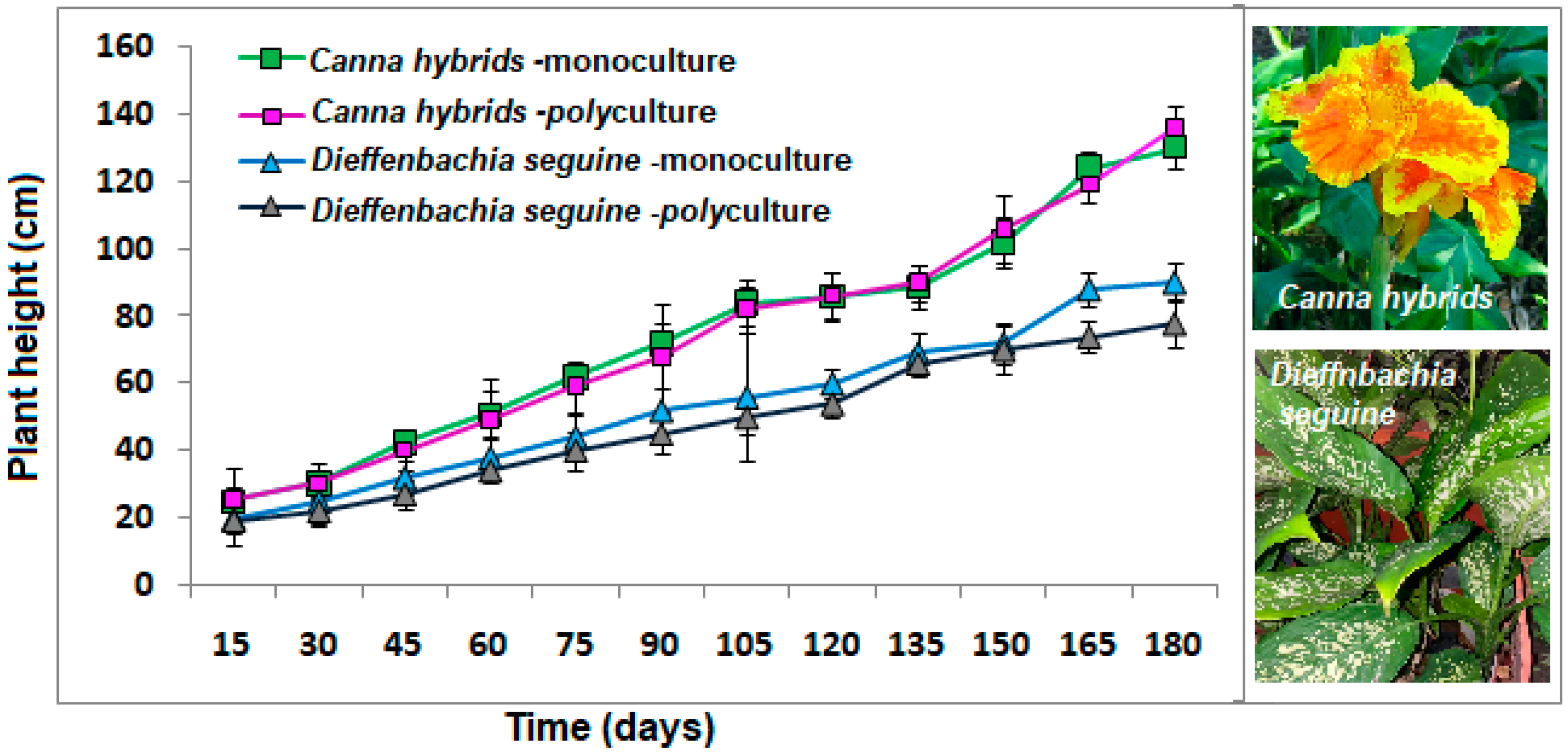
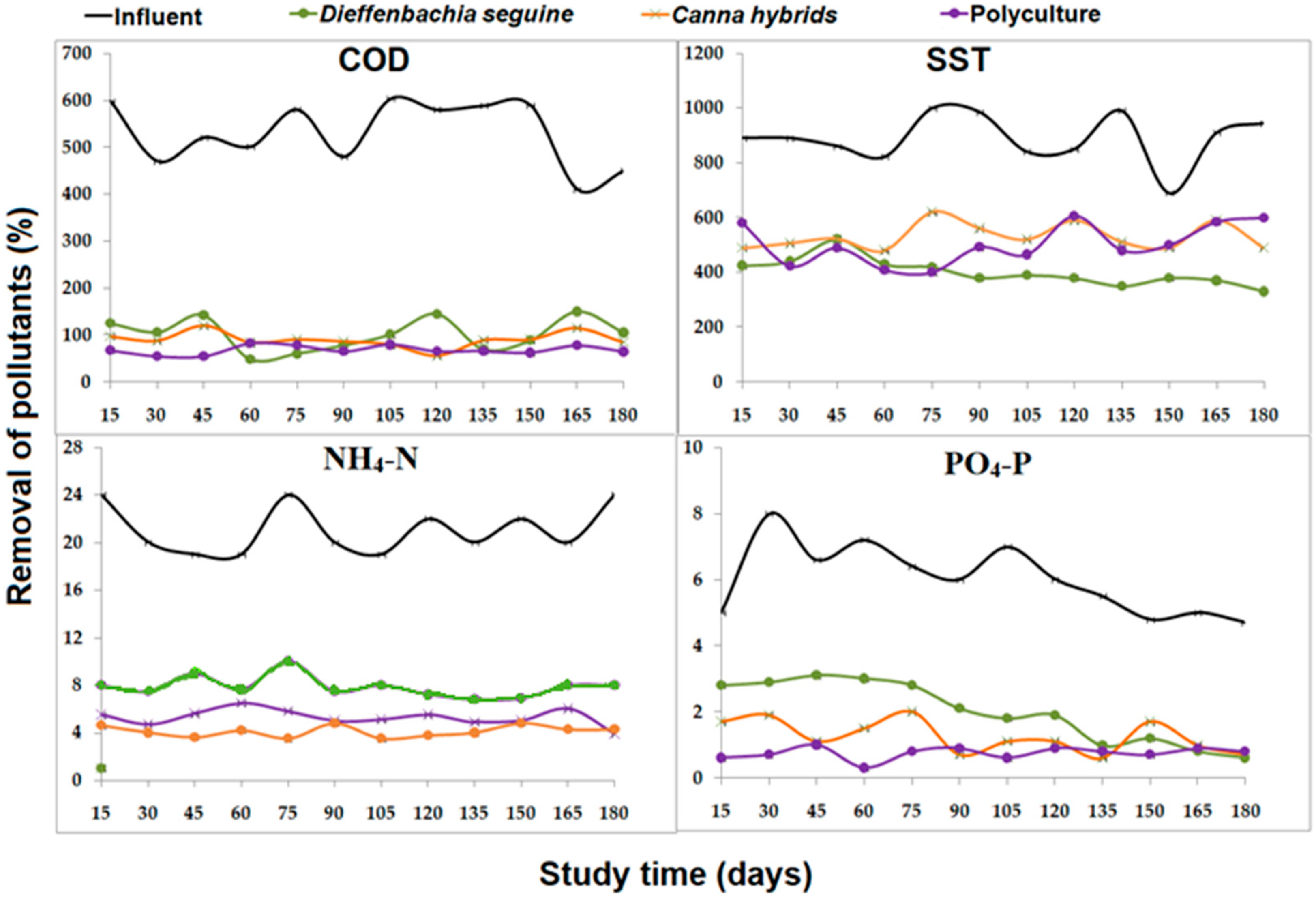
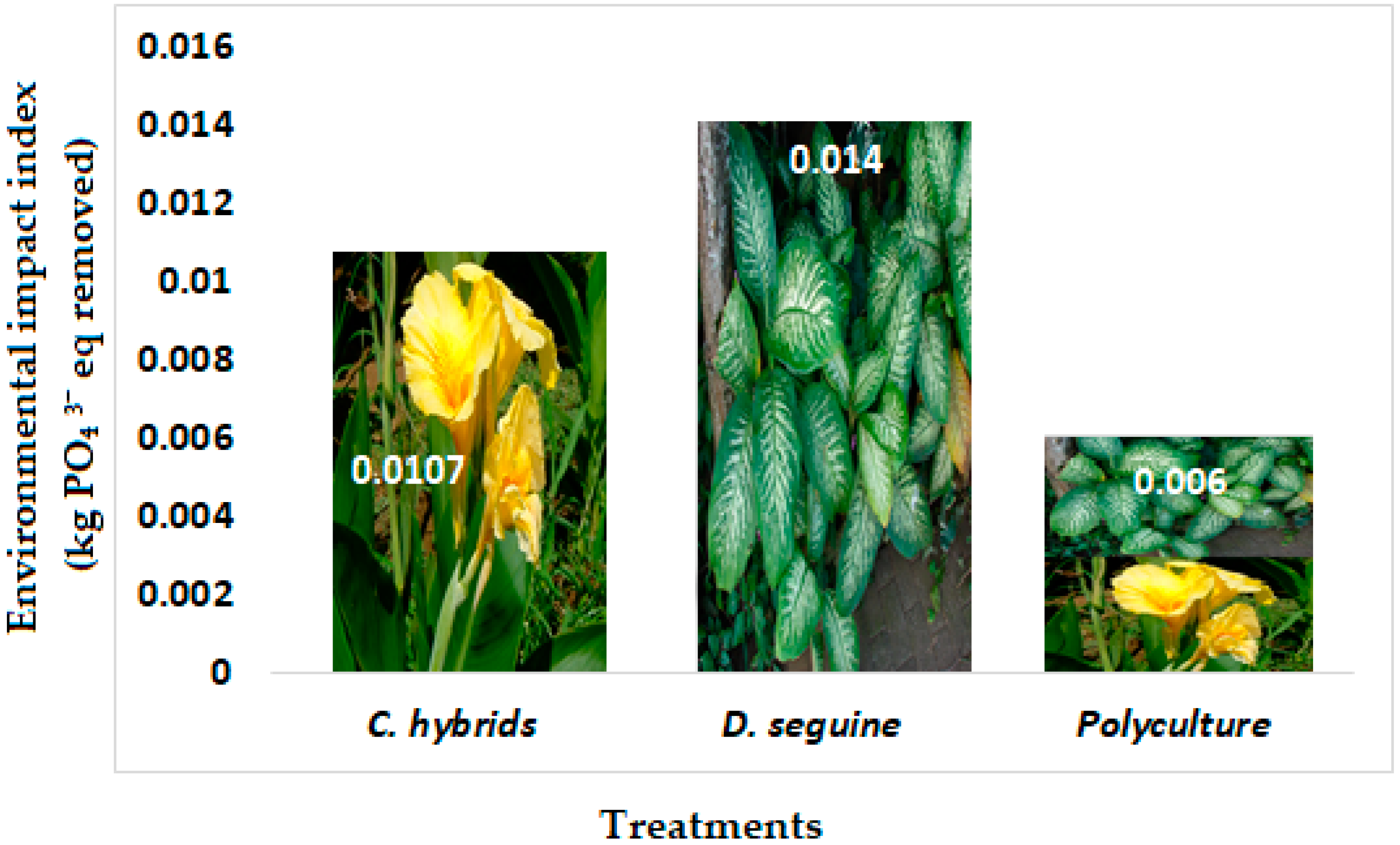
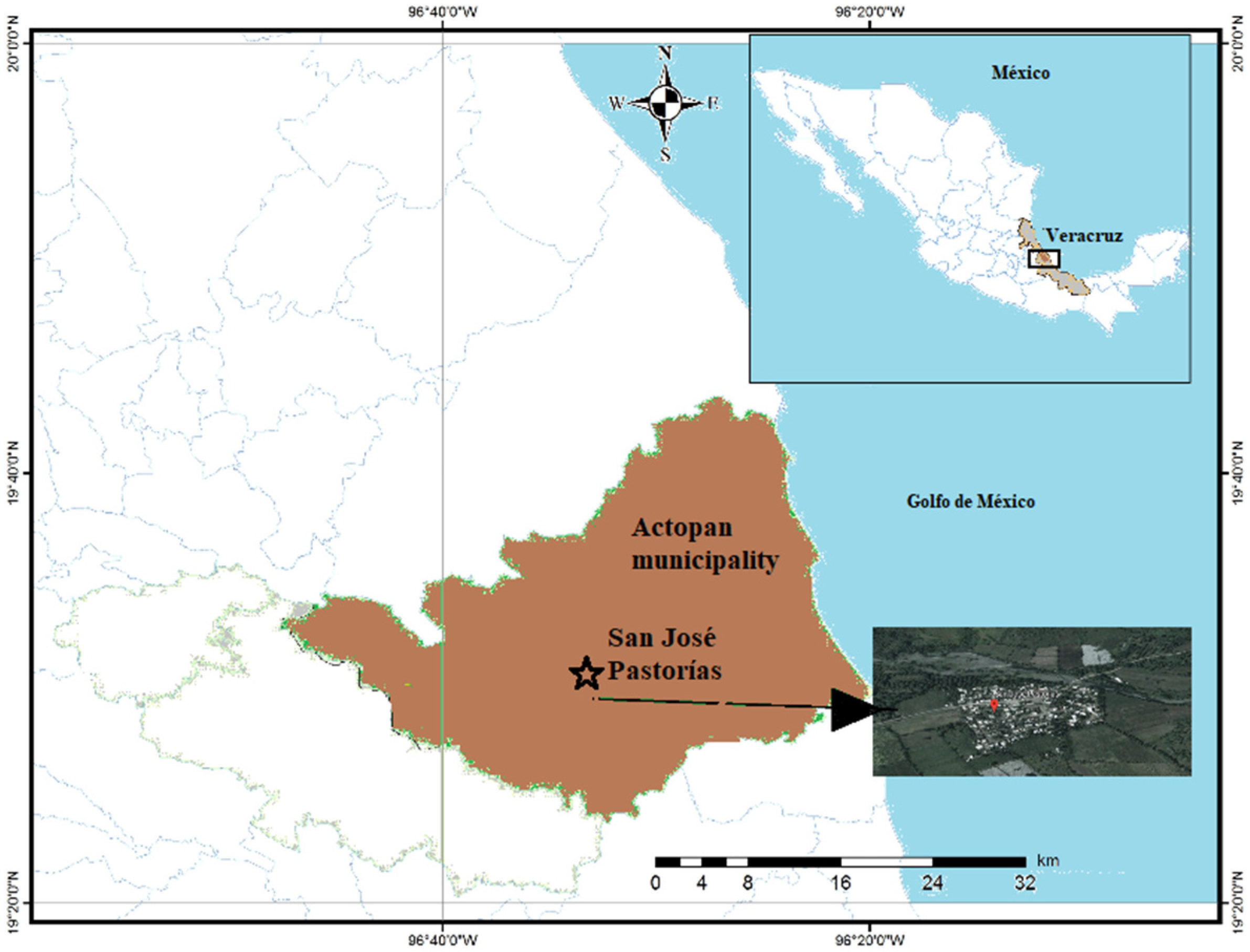
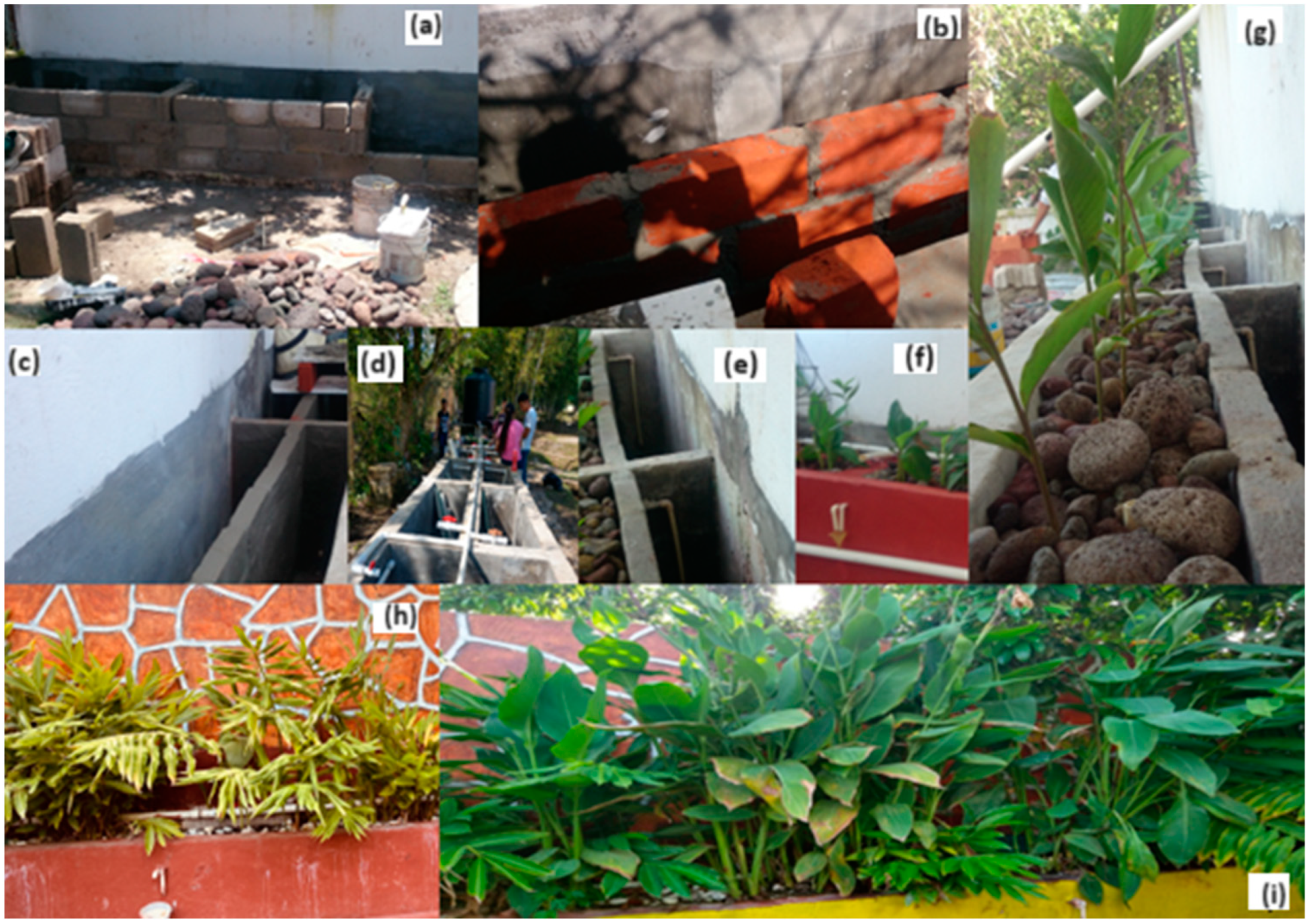
| Parameters | Monoculture CWs | Polyculture CWs | ||
|---|---|---|---|---|
| Influent | Dieffenbachia seguine | Canna hybrid | Dieffenbachia seguine + Canna hybrid | |
| pH (pH units) | 7.4 ± 0.3 | 7.6 ± 0.3 | 7.6 ± 0.3 | 7.6 ± 0.4 |
| DO (mg L−1) | 1.1 ± 0.3 | 3.8 ± 0.4 | 3.9 ± 0.6 | 4.1 ± 0.3 |
| Temperature (°C) | 20.2 ± 0.5 | 18.6 ± 0.6 | 18.2 ± 1.4 | 18.6 ± 0.2 |
| Parameters | Monoculture CWs | Polyculture CWs | |||||
|---|---|---|---|---|---|---|---|
| Dieffenbachia seguine | Canna hybrid | Dieffenbachia seguine + Canna hybrid | |||||
| Inflow Concentration (mg/L) | Outflow Concentration (mg/L) | Removal (%) | Outflow Concentration (mg/L) | Removal (%) | Outflow Concentration (mg/L) | Removal (%) | |
| TSS | 889.4 ± 99.3 | 401.2 ± 52.1 | 54.9 ± 9.1 a | 530.3 ± 20.3 | 44 ± 9.2 a | 502.7 ± 22.6 | 43.5 ± 4.9 a |
| COD | 530.4 ± 90.1 | 102.1 ± 18.2 | 80.8 ± 7.3 a | 90.1 ± 9.6 | 83.0 ± 5.7 a | 68.6 ± 16.3 | 87.1 ± 4.4 a |
| NH4-N | 21.3 ± 5.4 | 7.8 ± 1.6 | 63.4 ± 8.3 b | 5.2 ± 0.8 | 75.6 ± 6.4 a | 4.1 ± 0.7 | 80.8 ± 8.7 a |
| PO4-P | 6.02 ± 0.9 | 1.9 ± 0.2 | 68.4 ± 9.6 b | 1.2 ± 03 | 80.1± 9.3 a | 0.8 ± 0.1 | 86.7 ± 10.6 a |
Disclaimer/Publisher’s Note: The statements, opinions and data contained in all publications are solely those of the individual author(s) and contributor(s) and not of MDPI and/or the editor(s). MDPI and/or the editor(s) disclaim responsibility for any injury to people or property resulting from any ideas, methods, instructions or products referred to in the content. |
© 2024 by the authors. Licensee MDPI, Basel, Switzerland. This article is an open access article distributed under the terms and conditions of the Creative Commons Attribution (CC BY) license (https://creativecommons.org/licenses/by/4.0/).
Share and Cite
Marín-Muñiz, J.L.; Zitácuaro-Contreras, I.; Ortega-Pineda, G.; López-Roldán, A.; Vidal-Álvarez, M.; Martínez-Aguilar, K.E.; Álvarez-Hernández, L.M.; Zamora-Castro, S. Phytoremediation Performance with Ornamental Plants in Monocultures and Polycultures Conditions Using Constructed Wetlands Technology. Plants 2024, 13, 1051. https://doi.org/10.3390/plants13071051
Marín-Muñiz JL, Zitácuaro-Contreras I, Ortega-Pineda G, López-Roldán A, Vidal-Álvarez M, Martínez-Aguilar KE, Álvarez-Hernández LM, Zamora-Castro S. Phytoremediation Performance with Ornamental Plants in Monocultures and Polycultures Conditions Using Constructed Wetlands Technology. Plants. 2024; 13(7):1051. https://doi.org/10.3390/plants13071051
Chicago/Turabian StyleMarín-Muñiz, José Luis, Irma Zitácuaro-Contreras, Gonzalo Ortega-Pineda, Aarón López-Roldán, Monserrat Vidal-Álvarez, Karina E. Martínez-Aguilar, Luis M. Álvarez-Hernández, and Sergio Zamora-Castro. 2024. "Phytoremediation Performance with Ornamental Plants in Monocultures and Polycultures Conditions Using Constructed Wetlands Technology" Plants 13, no. 7: 1051. https://doi.org/10.3390/plants13071051
APA StyleMarín-Muñiz, J. L., Zitácuaro-Contreras, I., Ortega-Pineda, G., López-Roldán, A., Vidal-Álvarez, M., Martínez-Aguilar, K. E., Álvarez-Hernández, L. M., & Zamora-Castro, S. (2024). Phytoremediation Performance with Ornamental Plants in Monocultures and Polycultures Conditions Using Constructed Wetlands Technology. Plants, 13(7), 1051. https://doi.org/10.3390/plants13071051












